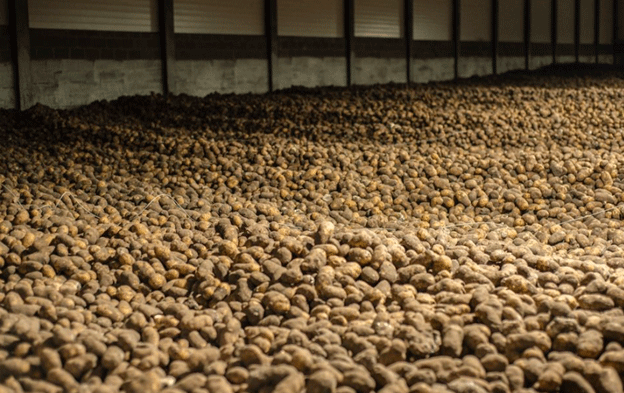As potato farmers brace for a challenging season, efficient storage has never been more important. The 2024 potato harvest in Russia is expected to be lower than last year, with forecasts suggesting a 15% decline in yields. Harsh weather conditions, including unexpected frosts, droughts, and heavy rains, have resulted in smaller tuber sizes and reduced volumes. With potato prices already climbing by up to 70% compared to last year’s levels, farmers must take steps to ensure that their yields are preserved until they can fetch higher prices in the spring.
In 2023, Russia harvested approximately 8.6 million tons of potatoes, achieving self-sufficiency in this crucial staple for the first time since 2015. However, the record harvest also exposed a critical issue: the scarcity of proper storage facilities. Even with a more modest harvest in 2024, this problem remains pressing, highlighting the need for innovative and effective storage methods.
Effective Storage: Smart Approaches
Farmers have several options for potato storage, each with its advantages and challenges. The three main methods are:
- Bulk Storage: The most cost-effective per kilogram but requiring efficient ventilation systems.
- Container Storage: Frequently used in seed production to maintain the quality and viability of seed potatoes.
- Pallet Bags: Popular for easy handling and inspection.
Regardless of the method chosen, the primary goal is to reduce the impact of external factors and manage the internal environment of the storage facility. Key conditions to monitor include temperature, humidity, and light exposure. Advanced climate control systems now offer comprehensive solutions, managing everything from drying to cooling and long-term storage.
Advanced Climate Control Systems
The post-harvest life of a potato is far from inactive. Proper drying is essential to eliminate excess moisture and prevent rot. The curing phase allows any cuts or bruises on the tubers to heal, minimizing spoilage. Cooling is then gradually introduced, with air temperatures lowered by only 0.5°C at a time to slow the tubers’ physiological processes. Modern climate systems can maintain up to 98% of the harvest in prime condition, an impressive feat that maximizes returns.
These systems can be retrofitted into existing buildings, such as repurposed barns or old livestock shelters. Experts recommend modifications such as sealing unused openings, insulating walls, and installing automated climate controls. Using existing structures can significantly lower the costs of setting up a storage facility.
Construction of Modern Potato Storage Facilities
For those investing in new storage facilities, innovative construction techniques offer efficiency and durability. Here is a breakdown of a seven-step process for building a modern, climate-controlled potato storage facility:
- Foundation Work: For arch-type buildings, a strip foundation with bored piles is ideal. This design ensures stability and can simplify the permitting process, as these structures are classified as non-capital buildings.
- Arch Fabrication: On-site, galvanized steel sheets (0.8-1.4 mm thick) are shaped into arches. These are then connected using rolling techniques to form 5-7 arch sections, making for quick and robust assembly.
- Arch Installation: The sections are lifted into place and secured to the foundation using a special seam-locking machine. This method allows for storage facilities of any length, tailored to a farm’s needs.
- Wall Construction: End walls are custom-built, including necessary openings for doors, windows, and machinery access. The design must accommodate large equipment, ensuring ease of use.
- Foundation Reinforcement: An additional layer of concrete strengthens the base and integrates it with the walls, enhancing durability.
- Installation of Access Points and Ventilation: Doors, windows, and ventilation shafts are mounted, ensuring that the facility is both secure and well-aerated.
- Insulation: A spray-applied polyurethane foam (PUF) layer is added for thermal efficiency. This material forms a seamless, moisture-resistant barrier that provides excellent insulation without adding weight to the structure.
Spray foam insulation not only enhances energy efficiency but also extends the lifespan of the facility by protecting the metal from corrosion and preventing condensation. It is mold-resistant, rodent-proof, and self-extinguishing, meeting high safety standards. Even after 25 years, the insulation can be easily refreshed, making it a cost-effective long-term investment.
Efficient potato storage is key to maximizing profits, especially in a year when yields are under pressure and prices are volatile. With modern climate control and smart construction techniques, farmers can significantly reduce losses and capitalize on market opportunities. Whether upgrading an existing structure or building a new one, the investment in proper storage pays off in both quantity and quality of the preserved harvest.
